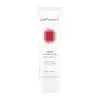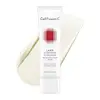What's inside
What's inside
 Key Ingredients
Key Ingredients

 Benefits
Benefits

 Concerns
Concerns

No concerns
 Ingredients Side-by-side
Ingredients Side-by-side

Water
Skin ConditioningZinc Oxide
Cosmetic ColorantCyclohexasiloxane
EmollientDibutyl Adipate
EmollientPropylheptyl Caprylate
EmollientButyloctyl Salicylate
Skin ConditioningDipropylene Glycol
HumectantPolyglyceryl-4 Diisostearate/Polyhydroxystearate/Sebacate
EmulsifyingNiacinamide
SmoothingCalcium Aluminum Borosilicate
Ethylhexyl Triazone
UV AbsorberMethyl Methacrylate Crosspolymer
Bis-Ethylhexyloxyphenol Methoxyphenyl Triazine
Skin ConditioningPolyglyceryl-3 Polydimethylsiloxyethyl Dimethicone
Skin ConditioningDiethylamino Hydroxybenzoyl Hexyl Benzoate
UV FilterTitanium Dioxide
Cosmetic ColorantMagnesium Sulfate
Disteardimonium Hectorite
StabilisingTriethoxycaprylylsilane
1,2-Hexanediol
Skin ConditioningWater, Zinc Oxide, Cyclohexasiloxane, Dibutyl Adipate, Propylheptyl Caprylate, Butyloctyl Salicylate, Dipropylene Glycol, Polyglyceryl-4 Diisostearate/Polyhydroxystearate/Sebacate, Niacinamide, Calcium Aluminum Borosilicate, Ethylhexyl Triazone, Methyl Methacrylate Crosspolymer, Bis-Ethylhexyloxyphenol Methoxyphenyl Triazine, Polyglyceryl-3 Polydimethylsiloxyethyl Dimethicone, Diethylamino Hydroxybenzoyl Hexyl Benzoate, Titanium Dioxide, Magnesium Sulfate, Disteardimonium Hectorite, Triethoxycaprylylsilane, 1,2-Hexanediol
Homosalate 6%
Skin ConditioningEthylhexyl Salicylate 4.5%
UV AbsorberOctocrylene 5%
UV AbsorberZinc Oxide 10.38%
Cosmetic ColorantWater
Skin ConditioningCaprylic/Capric Triglyceride
MaskingPropanediol
SolventGlycerin
HumectantCoco-Caprylate/Caprate
EmollientCetearyl Olivate
Sphingomonas Ferment Extract
Skin ConditioningHippophae Rhamnoides Oil
EmollientSodium Hyaluronate
HumectantHamamelis Virginiana Water
AstringentHouttuynia Cordata Extract
Skin ConditioningCentella Asiatica Extract
CleansingPentylene Glycol
Skin Conditioning1,2-Hexanediol
Skin ConditioningSorbitan Olivate
EmulsifyingGlyceryl Stearate
EmollientPotassium Cetyl Phosphate
EmulsifyingLauroyl Lysine
Skin ConditioningPolyhydroxystearic Acid
EmulsifyingHydroxyacetophenone
AntioxidantSodium Polyacryloyldimethyl Taurate
Emulsion StabilisingAcrylates Copolymer
Triethoxycaprylylsilane
Stearic Acid
CleansingPanthenol
Skin ConditioningTromethamine
BufferingNeopentyl Glycol Diethylhexanoate
EmollientPolyacrylate Crosspolymer-6
Emulsion StabilisingHydroxypropyl Methylcellulose Stearoxy Ether
Trisodium Ethylenediamine Disuccinate
Acetyl Glucosamine
Skin ConditioningBiosaccharide Gum-1
HumectantSodium Hyaluronate Crosspolymer
HumectantCaprylyl Glycol
EmollientHydrogenated Lecithin
EmulsifyingButylene Glycol
HumectantCeramide NP
Skin ConditioningSucrose Stearate
EmollientPalmitic Acid
EmollientCholesterol
EmollientCeramide Ns
Skin ConditioningGlycosphingolipids
EmollientPhytosphingosine
Skin ConditioningCeramide AP
Skin ConditioningCeramide As
Skin ConditioningEthylhexylglycerin
Skin ConditioningSodium Dna
Skin ConditioningCeramide EOP
Skin ConditioningCetearyl Alcohol
EmollientParfum
MaskingHomosalate 6%, Ethylhexyl Salicylate 4.5%, Octocrylene 5%, Zinc Oxide 10.38%, Water, Caprylic/Capric Triglyceride, Propanediol, Glycerin, Coco-Caprylate/Caprate, Cetearyl Olivate, Sphingomonas Ferment Extract, Hippophae Rhamnoides Oil, Sodium Hyaluronate, Hamamelis Virginiana Water, Houttuynia Cordata Extract, Centella Asiatica Extract, Pentylene Glycol, 1,2-Hexanediol, Sorbitan Olivate, Glyceryl Stearate, Potassium Cetyl Phosphate, Lauroyl Lysine, Polyhydroxystearic Acid, Hydroxyacetophenone, Sodium Polyacryloyldimethyl Taurate, Acrylates Copolymer, Triethoxycaprylylsilane, Stearic Acid, Panthenol, Tromethamine, Neopentyl Glycol Diethylhexanoate, Polyacrylate Crosspolymer-6, Hydroxypropyl Methylcellulose Stearoxy Ether, Trisodium Ethylenediamine Disuccinate, Acetyl Glucosamine, Biosaccharide Gum-1, Sodium Hyaluronate Crosspolymer, Caprylyl Glycol, Hydrogenated Lecithin, Butylene Glycol, Ceramide NP, Sucrose Stearate, Palmitic Acid, Cholesterol, Ceramide Ns, Glycosphingolipids, Phytosphingosine, Ceramide AP, Ceramide As, Ethylhexylglycerin, Sodium Dna, Ceramide EOP, Cetearyl Alcohol, Parfum
 Reviews
Reviews

Ingredients Explained
These ingredients are found in both products.
Ingredients higher up in an ingredient list are typically present in a larger amount.
1,2-Hexanediol is a synthetic liquid and another multi-functional powerhouse.
It is a:
- Humectant, drawing moisture into the skin
- Emollient, helping to soften skin
- Solvent, dispersing and stabilizing formulas
- Preservative booster, enhancing the antimicrobial activity of other preservatives
Triethoxycaprylylsilane is a silicone used to bind and stabilize ingredients.
As an emulsifier, it helps prevent ingredients from separating. This can help elongate the shelf life of products.
Triethoxycaprylylsilane is often used to coat mineral sunscreens ingredients to help give a better feel. It also helps reduce oxidative stress in sunscreens.
Learn more about TriethoxycaprylylsilaneWater. It's the most common cosmetic ingredient of all. You'll usually see it at the top of ingredient lists, meaning that it makes up the largest part of the product.
So why is it so popular? Water most often acts as a solvent - this means that it helps dissolve other ingredients into the formulation.
You'll also recognize water as that liquid we all need to stay alive. If you see this, drink a glass of water. Stay hydrated!
Learn more about WaterZinc Oxide is a mineral broad-spectrum UV filter; it is the broadest UVA and UVB reflector approved by the FDA. It also has skin protectant and skin soothing properties.
Zinc oxide is one of the most effective broad-spectrum UV filters. It protects against UVB, UVAII, and UVAI. In comparison to its counterpart titanium dioxide, zinc oxide provides uniform and extended UVA protection.
Another great benefit? This ingredient is highly photostable so it won't degrade easily under sunlight.
A common myth is that mineral UV filters are widely believed to primarily reflect UV light.
However, modern research shows titanium dioxide absorbs UV radiation like chemical filters (~95% absorption & 5% reflection).
Zinc oxide has great skin soothing properties so you'll likely find this in sunscreens formulated for sensitive skin or babies/children. It is unlikely to cause "eye sting" like other sunscreen ingredients.
Regulatory agencies consider zinc oxide to be non-toxic and safe. It has also been shown to not penetrate the skin.
Unfortunately, this ingredient does leave a visible white cast. This is why mineral sunscreens are often less cosmetically elegant than chemical or hybrid ones.
In cosmetics, zinc oxide can be found in both non-nano and nano-sized forms. The nano version is used to reduce white cast and improve the texture of sunscreen formulas.
There are ongoing concerns surrounding nano-zinc oxide's impact on marine ecosystems and whether it can be absorbed into skin.
Regarding marine ecosystems and coral reefs, there is no conclusive evidence that any form of zinc oxide (or any other sunscreen ingredients) will cause harm. The science is still developing but many consumers are keeping a close eye on this issue.
Please note, many destinations have reef-safety sunscreen rules. For instance, the U.S. Virgin Islands advises all visitors to use non-nano mineral sunscreens.
There has also been some stir about whether micronized or nano zinc oxide has potential photoxicity and absorption through the skin/lungs.
An in-vitro (done in a test tube or petri dish) study demonstrated micronized zinc oxide to have potential phototoxicity. There's no need to fret; the EU Commission's Scientific Committee on Consumer Safety has stated, "The relevance of these findings needs to be clarified by appropriate investigations in vivo." Or in other words, further studies done on living organisms are needed to prove this.
Current research shows zinc oxide nanoparticles do not penetrate intact or sunburned skin. They either remain on the surface or in the outermost layer of dead skin (stratum corneum).
Zinc oxide is one of only two classified mineral UV filters with titanium dioxide being the other one.
Fun fact: Zinc has been used throughout history as an ingredient in paint and medicine. An Indian text from 500BC is believed to list zinc oxide as a salve for open wound. The Ancient Greek physician Dioscorides has also mentioned the use of zinc as an ointment in 1AD.
Learn more about Zinc Oxide